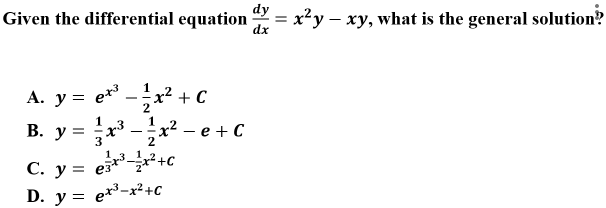AP Calculus AB/BC ♾️
279 resourcesSee Units
Answers and Review for Multiple Choice Practice on Differential Equations

⛔STOP!⛔ Before you look at the answers make sure you gave this practice quiz a try so you can assess your understanding of the concepts covered in unit 1. Click here for the practice questions: AP Calculus Unit 7 Multiple Choice Questions. Facts about the test: The AP Calculus exam has two sections of multiple choice: 30 questions in 60 minutes with no calculator, and 15 questions in 45 minutes with a calculator. *The following questions were not written by CollegeBoard and although they cover information outlined in the AP Calculus Course and Exam Description the formatting on the exam may be different.

Explanation: B is correct because to represent this function, you need to remember that rate is a derivative, directly proportional is multiplication, and translating to the left one place is a positive one. Remember that k is the constant of proportionality and needs to be present for those representations of direct/inverse proportions.
📄 Study Unit 7.0: Differential Equations
2.

Explanation: C is correct because solutions to differential equations can be found by taking derivatives and substituting their values into the expression given. Remember to know the derivative rules cold.
3.

Explanation: D is correct because test the differential equation by taking their first and second derivative. Remember your derivatives rules when dealing with constants. e to the 3 is a constant and its derivative is 0.
4.

Explanation: When sketching slope fields, the points need to be substituted into the differential equation. Once the information is determined you can find the slope at that point.
📄 Study Unit 7.3: Sketching Slope Fields
5.

C is correct because when looking at a slope field, start with the things you know. The slope field does not exist where x < 0. This would eliminate all differential equations except for ln x.
📄 Study Unit 7.3: Sketching Slope Fields
6.

A is correct because use the initial condition to eliminate any choices by substituting into the equation. Then determine if there are any special conditions from the slope field, such as slope of 0, slope is undefined, or slope is positive/negative. Use those to narrow down the remaining choices.
📄 Study Unit 7.3: Sketching Slope Fields
7.

B is correct because

📄 Study Unit 7.3: Sketching Slope Fields
8.

Explanation: B is correct because to determine a particular solution, separate variables and integrate. Once you have integrated, solve for y and do not forget the + C.
9.

Explanation: C is correct because separate the variables and integrate. Remember when you integrate to include the constant obtained by the power rule. Do not forget + C.
10.

Explanation: B is correct because in this general solution, you need to separate the variables and integrate. In this problem it is important to keep up with the negatives and do not forget the + C.
11.

Explanation: A is correct because in this trigonometric separation of variables problem, you will need to solve for y by applying inverse trigonometric functions. Do not forget the + C.
12.

Explanation: C is correct because once you separate your variables, you need to integrate. Then plug in the solution to solve for C. Replace C in the solution to get the particular solution.
13.

Explanation: D is correct because once you separate your variables, you need to integrate. Then plug in the solution to solve for C. Verify the condition to make sure you have the correct sign in front of your square root.
14.

Explanation: C is correct because when utilizing separation of variables, you will need to utilize the integrations rules and (at times) the trig rules from previous courses. Be sure to integrate and plug in the initial condition to determine the particular solution for this condition.
15.

Explanation: B is correct because

What can we help you do now?
🤝Connect with other students studying AP Calculus with Hours
Browse Study Guides By Unit
👑Unit 1 – Limits & Continuity
🤓Unit 2 – Fundamentals of Differentiation
🤙🏽Unit 3 – Composite, Implicit, & Inverse Functions
👀Unit 4 – Contextual Applications of Differentiation
✨Unit 5 – Analytical Applications of Differentiation
🔥Unit 6 – Integration & Accumulation of Change
💎Unit 7 – Differential Equations
🐶Unit 8 – Applications of Integration
🦖Unit 9 – Parametric Equations, Polar Coordinates, & Vector-Valued Functions (BC Only)
♾Unit 10 – Infinite Sequences & Series (BC Only)
🧐Multiple Choice Questions (MCQ)
✍️Free Response Questions (FRQ)
📆Big Reviews: Finals & Exam Prep

© 2023 Fiveable Inc. All rights reserved.